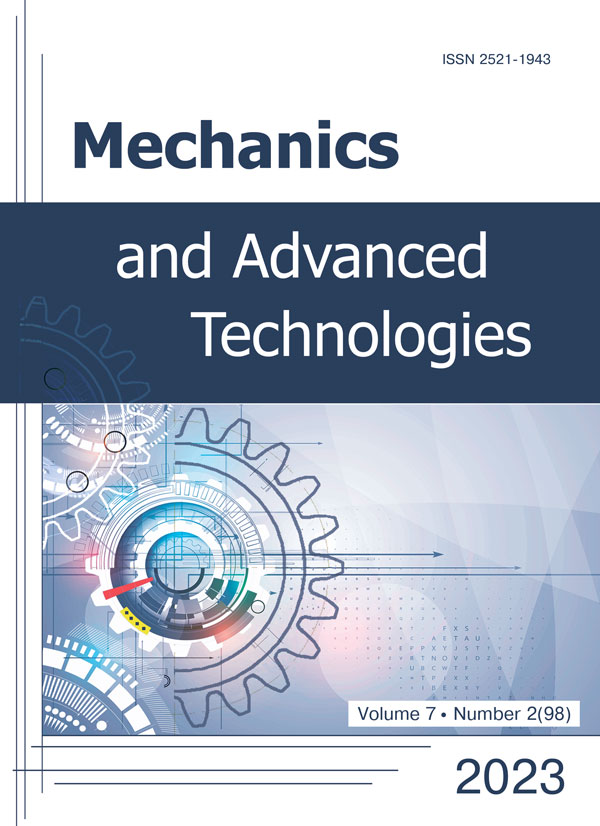Damage of materials under proportional loading
DOI:
https://doi.org/10.20535/2521-1943.2023.7.2.261955Keywords:
elasticity modules, damage, kinetic processes, loosening of materialAbstract
The work is devoted to the study of material damage during elasto-plastic proportional loading, in particular, the influence of two loading mechanisms, detachment and shear, is taken into account. These mechanisms include viscous, brittle, and visco-brittle modes of failure. The accumulation of scattered damage is considered as a multi-scale and multi-stage phenomenon that occurs during proportional loading at the micro- and meso-levels of the destruction of the metal structural material.
As part of the study, a quantitative assessment of the degradation of the physical and mechanical properties of materials was performed, in particular, changes in the modulus of elasticity E and G, and the definition of equivalent damage arising from an elastoplastic proportional load is proposed. Experimental data on the kinetics of damage accumulation on 12X18N10T steel samples, which were subjected to axial load (tension), shear (torsion) and proportional load with the stiffness parameter of the stress state K = 0.5 before failure, are considered.
The work compares experimental results with theoretical data, damage accumulation. The obtained conclusions contribute to a deeper understanding of the mechanisms of destruction of materials under the action of a proportional load, and can also find practical application in the design and assessment of the load-bearing capacity of structural elements.
References
- L. M. Kachanov, Introduction to Continuum Damage Mechanics. Dordrecht: Springer Netherlands, 1986, 135 p. DOI: https://doi.org/10.1007/978-94-017-1957-5.
- Yu. N. Rabotnov, Introduction to Damage Mechanics. Moscow: Nauka, 1987, 80 p.
- M. I. Bobyr, O. P. Khalimon and O. A. Bondarets, “Modeling of scattered damage accumulation kinetics under combined stress”, Strength of Materials, vol. 44, no. 1, pp. 20–26, 2012. DOI: https://doi.org/10.1007/s11223-012-9344-y.
- A. P. Grabovskiy and A. A. Bondaretc, “Deformatsionnyye modeli kinetiki povrezhdayemosti konstruktsionnykh materialov pri uprugoplasticheskom deformirovanii”, Vestnik Gomelskogo gosudarstvennogo tekhnicheskogo universiteta im. P. O. Sukhogo, no. 1 (52), 2013.
- O. A. Bondarets, A. P. Grabovskyi and I. I. Babiienko, “Damage model for calculating the failure of structural materials”, Mech. Adv. Technol., no. 3(87), pp. 38–46, Dec. 2019. DOI: https://doi.org/10.20535/2521-1943.2019.87.189812.
- V. V. Novozhilov and Yu. I. Kadashevich, Mikronapryazheniya v konstruktcionnykh materialakh. Leningrad: Mashinostroyeniye, 1990, 223 p.
- V. V. Novozhilov, Yu. I. Kadashevich and O. G. Rybakina, “Razrykhleniye i kriterii razrusheniya v usloviyakh polzuchesti”, Doklady AN SSSR, vol. 270, no. 4, pp. 831–835, 1983.
- J. Lemaitre and J.-L. Chaboche, "Damage mechanics", in Mechanics of Solid Materials. Cambridge University Press, 1990, pp. 346-450. DOI: https://doi.org/10.1017/CBO9781139167970.011.
- J. Lemaitre and R. Desmorat, Engineering Damage Mechanics. Berlin, Heidelberg: Springer-Verlag, 2005, 380 p. DOI: https://doi.org/10.1007/b138882.
- A. Ganczarski and L. Barwacz, “Notes on Damage Effect Tensors of Two-Scalar Variables”, International Journal of Damage Mechanics, vol. 13, no. 3, pp. 287–295, 2004. DOI: https://doi.org/10.1177/1056789504045442.
- C. Y. Tang, W. Shen, L. H. Peng and T. C. Lee, “Characterization of Isotropic Damage Using Double Scalar Variables”, International Journal of Damage Mechanics, vol. 11, no. 1, pp. 3–25, 2002. DOI: https://doi.org/10.1106/105678902023194.
- A. V. Khaneft, Osnovy teorii uprugosti. Teoriya uprugosti. Kemerovo: Kemerovskiy gosudarstvennyy universitet, 2009, 100 p.
- M. I. Bobyr, V. V. Koval’ and D. K. Fam, “Phenomenological Criterion of the Limit State of Structural Materials with Account of their Damageability”, Strength of Materials, vol. 52, no. 6, pp. 821–831, 2020. DOI: https://doi.org/10.1007/s11223-021-00236-8.
- B. Erice and F. Galvez, “A coupled elastoplastic-damage constitutive model with Lode angle dependent failure criterion”, Int. J. Solids Struct., vol. 51, no. 1, pp. 93–110, 2014. DOI: https://doi.org/10.1016/j.ijsolstr.2013.09.015.
Downloads
Published
How to Cite
Issue
Section
License
Copyright (c) 2023 Анатолій Грабовський, Олександр Бондарець, Ірина Бабієнко

This work is licensed under a Creative Commons Attribution 4.0 International License.
Authors who publish with this journal agree to the following terms:
- Authors retain copyright and grant the journal right of first publication with the work simultaneously licensed under CC BY 4.0 that allows others to share the work with an acknowledgement of the work's authorship and initial publication in this journal.
- Authors are able to enter into separate, additional contractual arrangements for the non-exclusive distribution of the journal's published version of the work (e.g., post it to an institutional repository or publish it in a book), with an acknowledgement of its initial publication in this journal.
- Authors are permitted and encouraged to post their work online (e.g., in institutional repositories or on their website) prior to and during the submission process, as it can lead to productive exchanges, as well as earlier and greater citation of published work











